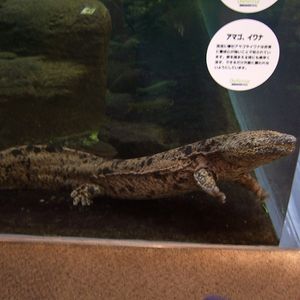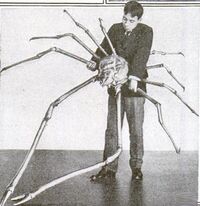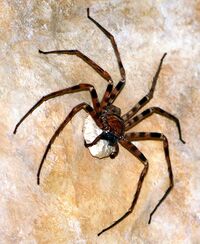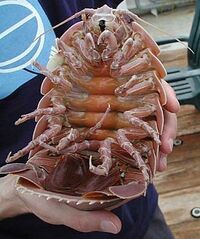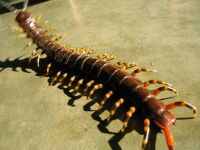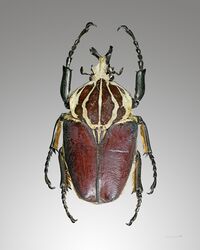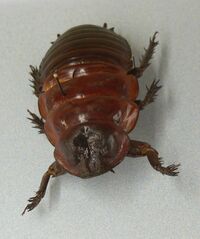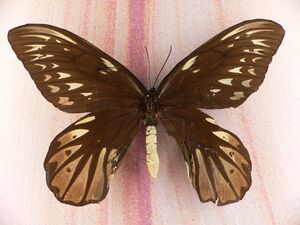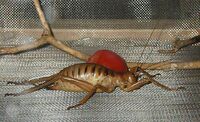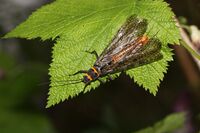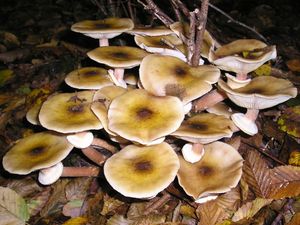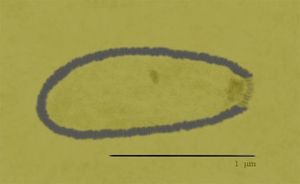أكبر الكائنات الحية
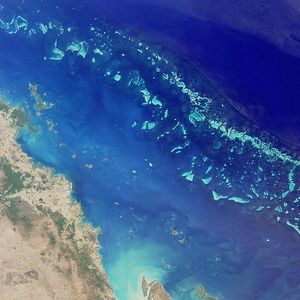
أكبر عضية وُجدت على سطح الأرض يمكن قياسها بطرق مختلفة. يمكن تعريفها كالأكبر حجماً أو كتلةً أو ارتفاعاً أو طولاً. بعض العضيات تجتمع معاً لتشكل كائناً عملاقاً، إلا أن تلك لا يمكن حقاً اعتبارها كعضية واحدة كبيرة. (الحاجز المرجاني العظيم، هو أكبر شعاب مرجانية في العالم، (إذ يمتد لمسافة 2,000 كم) قد اتضح أنه مجموعة من عضيات عديدة).
تشكل شجرة الحور (Populus tremuloides) شوادر ضخمة من أشجار متطابقة جينياً تماماً (فنياً، جذوعها) متصلة بنظام جذور واحد تحت الأرض. وتشكل هذه الشجرات عبر براعم الجذور النابتة من الشجرة الأم، بالرغم من أن نظام الجذور قد لا يبقى كوحدة واحدة في كل الحالات. وأكبر أيكة حور معروفة كاملة الاتصال توجد في ولاية يوتاه، الولايات المتحدة وتـُسمى پاندو، ويسميها بعض الخبراء أكبر كائن حي في العالم،[1] حسب الكتلة أو الحجم.[2] فهي تغطي 0.43 كم2 (106 فدان) ويقدر وزنها بحوالي 6600 طن. [3]
وُجد الفطر العملاق من النوع Armillaria ostoyae ( فطر العسل) في ماهور الوطنية للغابات في ولاية أوريغون بمجال 8.9 km2 (2,200 acres)[4]، مما يجعله أكبر كائن حي من حيث المساحة. ومع ذلك، فإن ما إذا كان هذا كائناً فردياً حقيقياً أم لا، فهو محل نزاع: فقد أشارت بعض الاختبارات إلى أن لديهم نفس التركيب الجيني،[5]ولكن ما لم يكن الغزل الفطري متصل بالكامل، فإنها مستعمرة نسيلية للعديد من الأفراد الأصغر. ومستعمرة استنساخية أخرى تنافس مستعمرات فطر عسلي و Populus في الحجم وهي خيط من النبات البحري العملاق، نبتة الپوسيدون، التي اكتُشفت في البحر الأبيض المتوسط بالقرب من جزر البليار. وتغطي نطاقاً يبلغ طوله حوالي 8 كيلومترات (4.3 ميلًا).[6]
باستثناء الأشجار متعددة السيقان، جنرال شرمان، سيكويا عملاقة (سيكويا ضخمة) وهي شجرة بحجم 1,487 m3 (52,500 cu ft) وستحمل لقب أكبر كائن حي في العالم، إذا قيست من حيث الحجم.[7]يبلغ ارتفاع هذه الشجرة 83.8 m (275 ft) ويقدر وزن الجذع وحده 2,000 short tons (1,800 t).
أكبر شجرة ذات جذع واحد قيست على الإطلاق كانت شجرة لندسي كريك، خشب الساحل الأحمر مع حجم جذع أدنى يزيد عن 2,500 m3 (88,000 cu ft) وكتلة تزيد عن 3,600 short tons (3,300 t). سقطت خلال عاصفة عام 1905.[8]
من حيث الحجم والوزن، أكبر حيوان حي معروف هو الحوت الأزرق، وهو نوع في خطر انقراض الذي يبلغ طوله القياسي الرسمي 33.58 m (110.2 ft)، والوزن 210 short أطنان (لأنثى الحامل). وهو أكبر حيوانات "الأرض" اليوم من حيث الكتلة هي ذكر ( الثور) فيل الأدغال الأفريقي (أفيال سافانا أو أفيال الأدغال); وزن أحد الأمثلة المعروفة تقريباً 12,272 kg (27,055 lb) على الرغم من أن بعض أنواع المنقرضة، بما في ذلك العديد من الديناصورات، كانت أكبر بكثير. فقد خلصت دراسة أجرتها جامعة هلسنكي في عام 1985 إلى أن الحد النظري للحيوانات التي تعيش على الأرض استناداً إلى الأنواع المعروفة من لمخطط الجسم يتراوح بين 100 و 1000 طن متري.[9]
. . . . . . . . . . . . . . . . . . . . . . . . . . . . . . . . . . . . . . . . . . . . . . . . . . . . . . . . . . . . . . . . . . . . . . . . . . . . . . . . . . . . . . . . . . . . . . . . . . . . . . . . . . . . . . . . . . . . . . . . . . . . . . . . . . . . . . . . . . . . . . . . . . . . . . . . . . . . . . . . . . . . . . . .
الفقاريات
الثدييات
يُعتقد أن، الحوت الأزرق (Balaenoptera musculus) ، وهو أحد أفراد رتبة الحيتانيات، أكبر الحيوانات الحية على الإطلاق، مع أكبر صوربود منقرض يُعتقد أنه يتجاوز الحوت الأزرق من حيث الأبعاد، [بحاجة لمصدر] لكن ليس في الوزن. أقصى وزن تم تسجيله كان 190 t (210 short tons) لعينة قياس 30 m (98 ft)، في حين يصل الأطول منها إلى أكثر من 33.3 m (109 ft)، سُجلت ولكن لم يتم وزنها.
فيل الأدغال الأفريقي (Loxodonta africana)، من رتبة الفيليات، من أكبر الحيوانات الحية على الأرض. ويصل وزن فيل الأدغال الأفريقي عند مولده إلى 100 kg (220 lb). أكبر فيل تم تسجيله قُتل في أنجولا عام 1974. كان ذكراً ووصل وزنه إلى 12,272 kg (27,055 lb)، وكان إجمال طوله (من الجذع إلى الذيل) 10.6 m (35 ft) وإرتفاع كتفيه 4.2 m (14 ft).
- الثدييات الأحادية (كظاميات (أحاديات المسلك))
أكبر أحادي المسلك موجود هو إيكيدنا الغربي طويل المنقار يصل وزنه إلى 16.5 كيلوغرام (36.4 رطل) ويبلغ طوله m.[10] أكبر حيوان أحادي ثديي حامل ( للبيض) على الإطلاق كانت من إيكيدنا المنقرضة Zaglossus hacketti، المعروفة فقط من عدد قليل من العظام التي وجدت في أستراليا الغربية. كان بحجم الخروف، ربما وصل وزنه إلى 100 كيلوغرام (220 رطل).
- الجيبيات (Marsupialia)
القنغر الأحمر (Macropus rufus) وهو أكبر كائن حي جرابي. الحد الأقصى لحجم هذه الثدييات النحيلة هو 100 kg (220 lb) و من ناحية الطول 1.92 m (6.3 ft).[11]وُجدت العديد من الجرابيات الأكبر حجماً في عصور ما قبل التاريخ، وكان أكبرها ثنائي الأسنان الأمامية. كان من الممكن أن يتجاوز حجم وحيد القرن بسهولة 2 طن (4,400 lb)، 3.3 m (11 ft) في الطول و 1.83 m (6 ft) في الارتفاع. شيطان تسمانيا هو أكبر جرابي آكل للحوم. يبلغ الحد الأقصى لحجم هذه الثدييات الممتلئة 10 كجم (22.2 رطل) وطول 91 سم (3 أقدام). أكبر جرابيات آكلة اللحوم على الإطلاق كان الأسد الجرابي والجرابي ذو أسنان بارزة كلاهما يتراوح بالطول من 5 ft (1.5 m) إلى 6 ft (1.8 m) ويزن ما بين 100 kg to 160 kg.
- الوحشيات الأفريقية اللا حافرية (Afroinsectiphilia)
أكبر أنواع هذا الفرع الحيوي (الذي يحتوي أيضاً على الزبابة الفيلية والمداليات والخلد الذهبي) هو آردڤارك. يصل طول آردڤارك عادةً إلى 1.3 متر ويصل وزنها إلى 65 كيلوغراماً، على الرغم من تسجيل أفراد بوزن 100 كيلوغرام (220 رطلاً).[12]

- ذوات الحوافر متساوية الأصابع (Artiodactyla)
أكبر الأنواع من حيث الوزن هو فرس النهر (Hippopotamus amphibius)، إذ يصل وزنه الأقصى 4,500 كج (10,000 رطل)، وطوله 4.8 م (16 ق) وعرضه 1.66 م وطوله (5.5 ق).[13] أطول الأنواع جسماً، وأعلى الحيوانات الأرضية قامةً، هي الزرافة (Giraffa camelopardalis)، بقياس يصل إلى 5.8 m، وعلى الرغم من كونها نحيلة نسبياً، إلا أنها تصل إلى أعلى وزن يبلغ 2000 كجم.[14]
- آكلات اللحوم (Carnivora)
أكبر الأنواع الآن، بإدراج زعنفيات الأقدام، فقمة الفيل الجنوبية (Mirounga leonina) من عائلة الفقميات. كان الحجم الأعلى المسجل لهذا النوع 5000 كيلوجرام (11000 رطل) وطوله 6.9 متر. أكبر الحيوانات آكلة اللحوم على الأرض هي الدب القطبي (Ursus maritimus) والدب البني (Ursus arctos)، وكلاهما من عائلة الدبيات وكلاهما يزن بشكل استثنائي ويزيد عن 1 طن، 3 m، و1.5 m بالطول عند الكتف. قد يكون الدب العملاق قصير الوجه (Arctodus simus) أكبر آكلات اللحوم البرية في الترتيب (بالإضافة إلى الدب الأكبر) بمتوسط وزن يقدر بـ 600-800 كجم[15].أكبر عضو حي في عائلة السنوريات وهي النوع الفرعي الببر السيبيري (Panthera tigris altaica)، الذي يبلغ متوسط وزنه حوالي 227 كيلوغرام للذكور، ولكن يمكن تصل إلى حوالي 272-306 كيلوغرام والأوزان التي تصل إلى 384 كيلوغرام غير مؤكدة. والأكبر هو الأسد الأمريكي (Panthera leo atrox) و"Smilodon populator"، وهو قط ذو أسنان سيفية. يمكن أن يصل تهجين السدبر (Panthera tigris × Panthera leo)، الذي تم تربيته في حديقة الحيوان لذكر الأسد وأنثى النمر، إلى وزن 798 kg[بحاجة لمصدر]، بطول 3.05 م.
- الحيتان (Cetacea)
أكبر حوت وحيوان هو الحوت الأزرق المذكور أعلاه، وهو حوت البالين (Mysticeti). أكبر حوت مسنن (Odontoceti) هو حوت العنبر، ويتراوح النطاق عادة حتى 18 متراً وكتلة 50 طناً، ولكن من المحتمل أن تنمو بشكل أكبر. الأوركا أو الحوت القاتل (Orcinus orca) هو أكبر أنواع عائلة الدلافين المحيطية (Delphinidae). تنمو الذكور عادة من 6.5 إلى 8 أمتار ويزيد وزنها عن 6 أطنان؛ أُبلغ عن أن الذكور كبيرة الحجم قد وصلت إلى ما يقرب من 8 أطنان. الإناث أصغر حجماً، حيث تنمو من 5.7 إلى 7 م ويبلغ وزنها حوالي 5 أطنان. أطول أوركا تم تسجيله على الإطلاق كان ذكراً قبالة سواحل اليابان، بقياس 9.8 متر.
- الخفافيش (Chiroptera)
أكبر أنواع الخفافيش هو الثعلب الطائر العملاق الذهبي المتوج (Acerodon jubatus)، وهو خفاش الفاكهة والأنواع المهددة بالانقراض وهو جزء من عائلة خفاش الفاكهة. يُعتقد أن الحد الأقصى للحجم يقترب من 1.5 كيلوغرام وطوله 55 سم، وقد يصل طول الجناح إلى 1.8 m. يُعتقد أن الخفاش الشبحي (Vampyrum spectrum)، بمتوسط 168 جراماً، 13.5 سم وحوالي 80 سم في جناحيها، هو الأكبر الخفافيش آكلة اللحوم، تنتمي إلى عائلة ميكروبات.
- الأرماديلو (Cingulata)
العملاق الموجود في هذه المجموعة هو المدرع الكبير (Priodontes maximus). الحجم الأعلى لهذا النوع هو 60 كيلوغرام و1.5 متر في الطول. تُعرف أمثلة أكبر بكثير من عصور ما قبل التاريخ، خاصة أخدودي الأسنان، التي تصدرت بسهولة بالطول 2.7 m والوزن 2 طن.
- الثدييات الشجرية (Dermoptera)
من بين نوعي الثدييات الشجرية بالترتيب Dermoptera للثدييات الشجرية المنزلقة في جنوب شرق آسيا، الأكبر والأكثر شيوعاً هو سوندا الليمور الطائر (Cynocephalus varigatus). الحجم الأقصى هو 2 kg و73 cm .
- القنافذ، الشوكيات، الزبابة، والشامات (الخلد) (Erinaceomorpha & Soricomorpha).
أكبر هاتين الرتبتين من الثدييات الصغيرة هي قنفذ القمر الكبير ('Echinosorex gymnura')، والتي يزيد حجمها الأقصى عن 2 kg و60 cm.
- وبر (أرنب الصخور) (Hyracoidea)
يبدو أن أكبر أنواع الوبر هي الوبر الصخري ('Procavia capensis')، حتى 5.4 كيلوغرام و73 cm.
- الأرانب، الأرانب الوحشية والبرانب (Lagomorpha)
أكبر الأنواع هي الأرنب الفلمنكي العملاق، والتي يصل وزنها إلى 12.7 كيلوغرام، الأرنب الأوروبي (Lepus europaeus)، حتى 6.6 كيلوغرام وبطول 76 سم.
- ذوات الحوافر الفردية الأصابع (Perissodactyla)
أكبر الأنواع الموجودة هي وحيد القرن الأبيض (Ceratotherium simum). أكبر وزن يمكن أن يصل إليه هذا النوع هو 4,500 kg وطول 4.7 m.[16]. إنه أكبر قليلاً من وحيد القرن الهندي. أكبر حيوان ثديي على الإطلاق كان "البهقرنوي" أو Indricotherium وحش بلوخستان (المعروف سابقاً باسم Baluchitherium)، وهو عضو في هذا النظام. يبلغ ارتفاعه 5.5 متراً، ويبلغ طوله أكثر من 9 أمتار وربما يصل وزنه إلى 20 طن على الرغم من اختلاف تقديرات الكتلة على نطاق واسع.
- آكل النمل الحرشفي (Pholiodata)
أكبر أنواع آكل النمل الحرشفي هو آكل النمل الضخم (Manis gigantea)، حتى 1.7 متر و40 كيلوجراماً على الأقل.
- آكل النمل و الكسلان (Pilosa)
أكبر الأنواع بسهولة هي آكل النمل العملاق (Myrmecophaga tridactyla). يمكن أن يصل وزن البالغ الكبير إلى 65 كجم ويبلغ طوله الإجمالي 2.4 m. حققت الكسلانيات أحجاماً أكبر بكثير في عصور ما قبل التاريخ، وكان أكبرها البهضم بمتوسط وزن يقدر بـ 4.5 طن وارتفاع 5.1 م، كان تقريباً في نفس حجم فيل الأدغال الأفريقي.
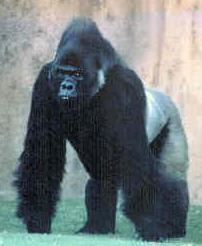
- الرئيسيات (Primates)
غوريلا الأراضي الشرقية المنخفضة (Gorilla beringei graueri) هي أكبر الرئيسيات الحية. يمكن أن يكون الحد الأقصى لحجم ذكر الغوريلا أكثر من 225 kg و1.83 m في البرية، مع تسجيل أوزان أثقل بكثير في الأسر. القردة الضخمة هو أكبر رئيسي معروف على الإطلاق، من المحتمل أن يبلغ متوسط طوله 3 أمتار (10 أقدام) ويزن 300 إلى 550 كجم (700 إلى 1200 رطل). عاشت منذ حوالي خمسة ملايين سنة إلى حوالي 300 ألف سنة في منطقة الهند والصين.
- البشر (Homo sapiens)
يمكن للبشر بلوغ أوزان هائلة (أكبر إنسان موثق على الإطلاق، جون برور مينوش الذي وزن 636 kg (1,402 lb). ومع ذلك، فهذه حالات مرضية كالبدانة والورم وأمراض طبية أخرى. وبالمثل، يمكن للبشر الوصول لأطوال هائلة (كانت أطوالهم الموثقة بحدود 8'11.2 بوصة (274 سم)، وكانت باسم روبرت وادلو) بسبب العملقة. حتى عندما لا يصاب الإنسان بالعملقة، فإن البشر هم أطول الرئيسيات الحية فقط وصل (باو تشيشون هو 7 ft 8 in).
- الفيلة والماموث والماستودون (Proboscidea)
خلافاً للاعتقاد الشائع، فإن معظم الأنواع المنقرضة في ترتيب الخرطوميات، مثل الماموث و الماستودون، لم تقزِِم فيل الأدغال الأفريقي. يُعتبر الماموث الملكي، التي يصل ارتفاعه إلى 5 أمتار، ودينوثيريم، والتي ربما تجاوز 14 طناً أكبر الأنواع بشكل عام. ومع ذلك، تشير الأدلة الحديثة إلى أن أكبر ماموث على الإطلاق كان ماموث نهر سونگهوا [بحاجة لمصدر] في الصين. كان ماموث السهوب ودينوثيريم هائلا الحجم أيضاً، حيث تنافس حجم ماموث نهر سونگهوا. في حين أن الفيلة الأفريقية لا يتجاوز وزنها عادة 7 أطنان، يمكن أن تتجاوز بعض العينات "الغريبة" 12 طن، مما يضع الفيل الأفريقي الحديث في قائمة أكبر الكائنات الحية الخرطومية على الإطلاق.
- القوارض (Rodentia)
أكبر القوارض الحية هي كاپيبارا، موطنها معظم الأجزاء الاستوائية والمعتدلة من أمريكا الجنوبية شرق الأنديز، دائماً قرب المياه. يمكن أن يصل حجم كاپيبارا الكامل إلى الحجم الأقصى 80 kg (180 lb)، 1.5 m (4.9 ft) بالطول، و90 cm (3.0 ft). أكبر قوارض معروفة على الإطلاق هي Josephoartigasia monesi، وهي نوع منقرض معروف فقط من الأحافير. كان طوله 3 metres (10 ft) وارتفاعه 1.5 metres (5 ft)، ويقدر وزنه بحوالي 1 طن.[17]قبل وصف J. monesi، كان أكبر أنواع القوارض المعروفة Phoberomys insolita. ومع ذلك، لا يُعرف هذا النوع إلا من بقايا غير مكتملة وبالتالي لا يمكن تقدير حجمه بأي دقة. اكتُشف هيكل عظمي مكتمل تقريباً لأقاربها الأصغر قليلاً العصر الميوسيني المتأخر Phoberomys pattersoni في ڤنزويلا في عام 2000; كان طوله 3 أمتار (10 أقدام)، مع ذيل إضافي يبلغ 1.5 متر (5 أقدام)، وربما وزَن حوالي 700 كيلوغرام (1540 رطل).
- فويسقات الأشجار (Scandentia)
يبدو أن أكبر زبابة الشجر هي زبابة الشجر الشائعة ('Tupaia glis')، والتي وصلت لـ 187 g و40 سم
- أبقار البحر (أطوم) وخراف البحر (Sirenia)
أكبر الأنواع الحية في رتبة الخيلانيات من الأطومات وخراف البحر هي خروف البحر الأمريكي ("Trichechus manatus"). الحد الأقصى لحجم هذا النوع هو 1590 كجم (3500 رطل) و 4.1 م. ومع ذلك، فإن بقرة البحر ستيلر ("Hydrodamalis gigas") كانت أكبر بكثير، حيث بلغ طولها 7.9 متر على الأقل ووزنها حتى 11 طن).
الزواحف
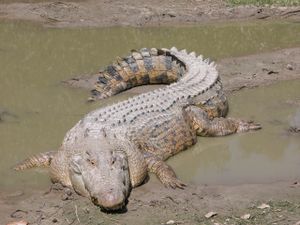
يعتبر تمساح المياه المالحة (Crocodylus porosus)، رتبة التمساحيات، أكبر الزواحف الحية، حيث يصل أطوال الذكور البالغة من 4.5 إلى 5 م (14.8 إلى 16.5 قدم)، ويصل وزنها إلى أكثر من 1,360 كج(3,000 lb).[18]
أشارت تقارير غير مؤكدة إلى وجود تماسيح يصل طولها إلى أكثر من ذلك، لكن لم يستدل عن وجود وجود تماسيح بأطول تزيد عن 7 م (23 قدم).[2]. ووصلت عينة حية إلى طول 7 م (23 قدم) ووصل وزنها إلى 2,000 كج(4,400 lb)، ومن المتوقع أن تسجل في كتاب جينس للأرقام القياسية.[19]
- الديناصورات (Dinosauria)
- انقرض الآن، باستثناء أحفاد ذوات الأقدام، طيور.


- كافة الديناصورات الكبرى، وأكبر الحيوانات التي عاشت على الأرض، كانت صوروپودا آكلة النبات. أطول وأثقل صوروپودا معروفة من هيكل عظمي كامل هي Brachiosaurus التي اكتُشفت في تنزانيا بين عامي 1907 و1912، وهي الآن مثبتة في متحف هومبولت برلين. يبلغ ارتفاعه 12 متر (38 قدم)، وربما يزن ما بين 30.000 - 60.000 كيلوجرام (30-65 طنًا). الأطول هو 27 متر (89 قدم) بالطول وديپلودوكس الذي اكتُشف في وايومنگ، وتم تركيبه في پتسبرگ في متحف كارنگي للتاريخ الطبيعي عام 1907.
الطيور

تعتبر النعامة (Struthio camelus) أكبر طائر حي على الأرض ، وهي أحد أفراد Struthioniformes، ويصل إرتفاعها إلى 2.7 م (9 قدم) ووزنها إلى أكثر من 156 كج (345 lb).[20] وقد تزن بيضة النعامة 1.4 كج(3 lb) وهي أكبر بيضة في عالم اليوم (وهي أيضا أكبر خلية لأي عضية، بالرغم من أن طحلب البحر Caulerpa يمكن إعتباره أنشط الخلايا أيضيا.
. . . . . . . . . . . . . . . . . . . . . . . . . . . . . . . . . . . . . . . . . . . . . . . . . . . . . . . . . . . . . . . . . . . . . . . . . . . . . . . . . . . . . . . . . . . . . . . . . . . . . . . . . . . . . . . . . . . . . . . . . . . . . . . . . . . . . . . . . . . . . . . . . . . . . . . . . . . . . . . . . . . . . . . .
البرمائيات
أكبر برمائيات حية هي السلمندر العملاق الصيني (أندرياس داڤيدانوس). الحد الأقصى لحجم هذا السمندل هو 64 كجم (140 رطل) و1.83 م (6 أقدام). قبل أن يصبح الحيوان البياض السائد رباعي الأرجل، كان هناك العديد من رباعيات الأرجل العملاقة الشبيهة بالبرمائيات. كان أكبرها معروف وهو التمساح - مثل پريونوسوكس، والذي بلغ طوله 9 أمتار.
- الضفادع (Anura)
أكبر عضو في أكبر رتبة من البرمائيات هو ضفدع گولياث الإفريقي الضفدع الجبَّارة (Conraua goliath). يبلغ الحد الأقصى لحجم هذا النوع وزن 3.8 كجم وطول خطم إلى فتحة يبلغ 35 سم. أكبر العلجوميات هو علجوم القصب. ومع ذلك، يمكن أن تنمو Beelzebufo ampinga المنقرض ليبلغ طول 40 سم (16 بوصة) ويصل وزنه إلى 4.5 كيلوغرام (10 رطل).
- الثعبانيات (عديمة الأرجل) (Gymnophiana)
أكبر أنواع الديدان الثعبانية هي الضفدع الثُعباني لِطومسون (Caecilia thompsoni)، والتي يصل طولها إلى 1.5 متر ويمكن أن يصل وزنها إلى حوالي 1 كجم.
الأسماك العظمية شعاعية الزعانف (Actinopterygii)
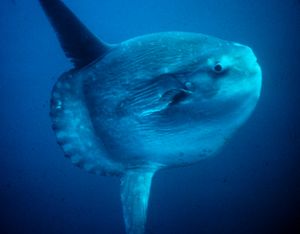
أكبر الأسماك العظمية الحية هي سمكة الشمس المحيطية (مولا مولا)، وهي عضو في النظام ينفوخيات الشكل. سُجلت سمكة الشمس بأحجام كبيرة تصل إلى ما يقرب من 3.6 م، وارتفاع 4.5 م من الزعنفة إلى الزعنفة ويبلغ وزنها حوالي 2،273 كجم. كانت أكبر الأسماك العظمية موجودة في عصور ما قبل التاريخ، وأكبرها على الإطلاق كانت الليدزيشثيس، من العصر الجوراسي. تتراوح تقديرات حجم هذه السمكة من 13.5 م إلى 30 م، ولكن الحجم الأقصى البالغ 22 m يبدو أكثر واقعية.
- الحفشيات (Acipenseriformes)
الأسماك الغضروفية (Chondrichthyes)

أكبر الأسماك الغضروفية، من رتبة قرشيات سجادية، هي القرش الحوتي، تم التحقق من حجمها حتى 13.6 متراً ووزنها 22 طناً. هناك العديد من الروايات عن أكبر قرش حوتي، ولكن ربما يكون هناك مبالغة في تقدير معظمها.
جدول أكبر الحيوانات الأرضية
القائمة التالية لأثقل حيوانات على الأرض. وقد أُدرِج حيوان الفظ بها لأنه يقضي وقت كبير على البر. لم يُقسم الفيل الأفريقي إلى نوعين منفصلين من فيل الأدغال الأفريقي وفيل الغابات الأفريقي لأنه لم يُقبل بالكامل بعد.
| الرتبة | الحيوان | متوسط الوزن (رطل) | أقصى وزن (رطل) | متوسط الطول (ق.) |
|---|---|---|---|---|
| 1 | الفيل الأفريقي[21] | 18,500 (8500 kg) | 27,000 (13000 kg) | 21.85 |
| 2 | الفيل الآسيوي[22] | 8,750 (4200 kg) | 11,000 (5200 kg) | 9.5 |
| 3 | الكركدن الأبيض | 5,000 (2350 kg) | 7,920 (3850 kg) | 12.5 |
| 4 | فرس النهر | 5,250 (2500 kg) | 7,100 (3400 kg) | 11 |
| 5 | الغور | 3,300 (1600 kg) | Unknown | 9.8 |
| 6 | الزرافة | 3,000 (1400 kg) | 4,400 (2100 kg) | 15.4 |
| 7 | الفظ | 2,645 (1200 kg) | 4,500 (2150 kg) | 11 |
| 8 | الكركدن الأسود | 2,420 (1150 kg) | 4,000 (1900 kg) | 11.25 |
| 9 | تمساح الماء المالح | 1,700 (785 kg) | 3,300 (1600 kg) | 20 |
| 10 | جاموس الماء الآسيوي البري | 1,684 (770 kg) | 2,640 (1250 kg) | 11.4 |
اللافقاريات
الإسفنجيات (Porifera)
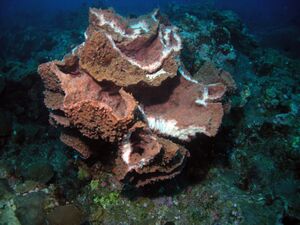
أكبر أنواع إسفنج البحر هو الإسفنج الأسطواني العملاق Xestospongia muta. يمكن أن تصل هذه الإسفنجيات الضخمة إلى ارتفاع 2.4 m (8 ft) ويمكن أن تكون بنفس السُمك تقريباً في الجزء الأكثر سمكاً من الهيكل.[23] يُقدر عمر بعض هذه المخلوقات بأكثر من 2400 سنة. [24]
- الإسفنج الجيري (Calcarea)
- من المحتمل أن يكون أكبر نوع معروف من هذه الإسفنجيات الصغيرة غير الواضحة هو النوع Pericharax heteroraphis، حيث بلغ ارتفاعه 30 cm (0.98 ft). معظم الإسفنج الجيري لا يتجاوز 10 cm (3.9 in) طولاً.[بحاجة لمصدر]
- الإسفنج الزجاجي (Hexactinellida)
- الأنواع الشائعة نسبياً، Rhabdocalyptus dawsoni، يمكن أن تصل إلى ارتفاع 1 m (3.3 ft) بمجرد أن تتقدم بعمرها.[25]وهو الحجم الأقصى المسجل للإسفنج الزجاجي السداسي.[بحاجة لمصدر]
اللاسعات (Cnidaria)
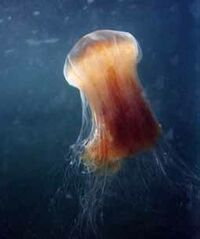
قنديل بحر عرف الأسد (Cyanea capillata) هو أكبر أنواع اللاسعات من فئة فنجانيات (لاسعات). أكبر عينة معروفة من هذا العملاق، وُجدت منجرفة على شاطئ خليج مساتشوستس في عام 1870،[26][27]يبلغ قطر الجرس 2.5 m (8.2 ft)، ووزنه 150 kg (330 lb). كانت مجسات هذه العينات بطول 37 m (121 ft) وكان من المتوقع أن يكون لها انتشار مجس يبلغ حوالي 75 m (246 ft) مما يجعلها واحدة من أطول الحيوانات الموجودة.[28]
- الشعاب المرجانية وشقائق النعمان البحرية (زهريات شعاعية)
- أكبر الأنواع الفردية هي شقائق النعمان البحرية من جنس Discoma، والتي يمكن أن تبلغ قطر قرص الفم 60 cm (2.0 ft).[29] Longer, but much less massive overall, are the anemones of the genus Ceriantharia, at up to 2 m (6.6 ft) tall.[30] يمكن أن تكون مجتمعات المرجانية ضخمة حقاً، يمكن أن تكون مستعمرة واحدة من الجنس الپوريت أكثر من 10 m (33 ft)، ولكن يشكل الفرد الفعلي للمستعمرة كائنات حية صغيرة جداً.
- الحيوانات الهيدرية (الأبابيات) (Hydrozoa)
- يمكن أن تصل المستعمرات السحارية Praya dubia إلى أطوال 40–50 m (130–160 ft).[31] يمكن أن يصل طول مجسات البارجة البرتغالية (Physalia physalis) إلى ما يصل إلى 50 m (160 ft).[32] في 6 أبريل 2020، أعلن معهد شميدت للمحيطات عن اكتشاف عملاق Apolemia سحاريات في الأخاديد المغمورة بالقرب من ساحل ننگالو، بقياس 15 م بحلقة يبلغ طولها حوالي 47 متراً، مدعياً أنها ربما كانت أكبر حاملة سحارية تم تسجيلها على الإطلاق.[33][34]
الديدان المفلطحة (Platyhelminthes)
- الديدان المفلطحة أحادية المنشأ (أحادية العائل)
- أكبر الأعضاء المعروفة لهذه المجموعة من الطفيليات الصغيرة جداً هم من جنس capsalids، Listrocephalos، ويصل طولها إلى 2 cm (0.79 in).[35]
- المثقوبات (Trematoda)
- أكبر الأنواع المعروفة من المثقوبات هي متوارقة بوسكية، والتي غالباً ما تهاجم الإنسان والماشية. يمكن أن يصل طول أحد هذه المثقوبات إلى 7.5 cm (3.0 in) وسماكة 2 cm (0.79 in).[36]
- الديدان الشريطية (Cestoda)
- أكبر أنواع الديدان الشريطية هي الدودة الشريطية للحوت، Polygonoporus giganticus، والتي يمكن أن تنمو إلى أكثر من 30 m (98 ft).[37][38]
. . . . . . . . . . . . . . . . . . . . . . . . . . . . . . . . . . . . . . . . . . . . . . . . . . . . . . . . . . . . . . . . . . . . . . . . . . . . . . . . . . . . . . . . . . . . . . . . . . . . . . . . . . . . . . . . . . . . . . . . . . . . . . . . . . . . . . . . . . . . . . . . . . . . . . . . . . . . . . . . . . . . . . . .
الديدان الأسطوانية (Nematoda)
أكبر الديدان الأسطوانية، Placentonema gigantissima،[39]وهي طفيلية موجودة في المشيمة من حوت العنبر والذي يمكن أن يصل طوله إلى 9 m (30 ft).[40]
الديدان المتقطعة (الديدان الحلقية)
أكبر الديدان المتقطعة (بما في ذلك ديدان الأرض، والعلقات، ومتعددة الأشواك) هي دودة الأرض الأفريقية العملاقة (Microchaetus rappi). على الرغم من أن متوسط طولها يبلغ حوالي 1.36 m (4.5 ft)، إلا أن هذه الدودة الضخمة يمكن أن تصل إلى طول يصل إلى 6.7 m (22 ft) ويمكنها تزن أكثر من 1.5 kg (3.3 lb).[41]فقط دودة أرض گبسلاند العملاقة، Megascolides australis، وعدد قليل من كثيرات الشعر العملاقة، بما في ذلك Eunice aphroditois، التي وصلت إلى أحجام مماثلة تقريباً، حيث وصلت إلى 4 and 3.6 m (13 and 12 ft)، على التوالي.[28]
شوكيات الجلد (Echinodermata)
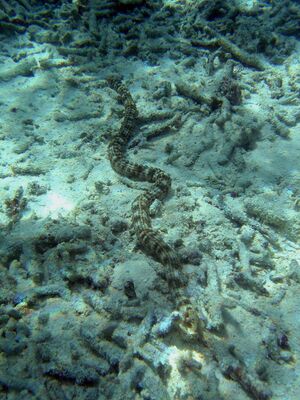
أكبر أنواع شوكيات الجلد من حيث الحجم هو على الأرجح نوع نجم البحر Thromidia gigas، من فئة شوكيات الجلد، والذي يصل وزنه إلى أكثر من 6 kg (13 lb)،[42] لكنها قد تتعرض للعنف من قبل بعض خيار البحر العملاق مثل Thelenota anax. ومع ذلك، بحد أقصى 63 cm (25 in)، يكون مصطلح Thromidia gigas أقصر قليلاً من بعض شوكيات الجلد الأخرى.[28]أطول شوكيات جلد معروف هو خيار البحر البارز Synapta maculata، مع جسم نحيف يمكن أن يمتد حتى 3 m (9.8 ft). وبالمقارنة، فإن أكبر نجم بحري هو نجم البحر الناصع Midgardia xandaros، حيث وصل إلى مدى 1.4 m (4.6 ft)، على الرغم من كونه نحيفاً للغاية.[28] Evasterias echinosoma هي شوكية الجلد العملاقة الأخرى بقياس يصل إلى 1 m (3.3 ft) بالعرض ووزن 5.1 kg (11 lb).[28]
- زنابق البحر (Crinoidea)
- أكبر أنواع زنبق البحر هو نجم الريش غير المطارِد Heliometra glacialis، ويبلغ عرضه الإجمالي 78 cm (31 in) وفرداً طول الذراع 35 cm (14 in). وزُعم عرضه 91.4 cm (36.0 in) لنجم ريش واحد غير متقطع ولكن لم يتم تأكيده.[28] جنس Metacrinus له امتداد ساق يبلغ 61 cm (24 in) ولكنه أثقل من Heliometra.[28] في الماضي، نمت زنابق البحر بشكل أكبر بكثير، وعُثر على أطوال ساق تصل إلى 40 m (130 ft) في السجل الأحفوري.[43]
- قنافذ البحر وأنسباؤها (Echinoidea)
- أكبر قنفذ البحر هو النوع Sperosoma giganteum من أعماق شمال غرب المحيط الهادئ، والذي يمكن أن يصل إلى عرض هيكلي حوالي 30 cm (12 in).[44]نوع آخر من قاطني أعماق البحار Hygrosoma hoplacantha أصغر قليلاً. [44]أكبر الأنواع الموجودة على طول ساحل أمريكا الشمالية هي المحيط الهادئ قنفذ البحر الأحمر (Mesocentrotus franciscanus) حيث يمكن أن يصل الهيكل إلى 19 cm (7.5 in).[45]إذا دخلت العمود الفقري في العد، فقد يكون أكبر الأنواع Diadematidae مثل Diadema setosum، مع قشرة تصل إلى 10 cm (3.9 in) فقط، ولكن يمكن أن تصل أشواكها إلى 30 cm (12 in) في الطول.[46]
- خيار البحر (Holothuroidea)
- أكبر أنواع خيار البحر هي Stichopus variegatus وThelenota anax، ويزن عدة أرطال تقريباً، حيث يبلغ وزنها حوالي 21 cm (8.3 in)، ويصل طوله إلى 1 m (3.3 ft) عند التمديد بالكامل. يمكن أن يصل طول Synapta maculata إلى 3 m (9.8 ft)، ولكنه نحيف للغاية (3-5 سم) ويزن أقل بكثير من Stichopodids.[28]
- نجم البحر الهش (Ophiuroidea)
- أكبر عينة معروفة لـ نجم البحر الهش وهي من عائلة النجم السلي Astrotoma agassizii. يمكن أن تنمو هذه الأنواع لتمتد بطول 1 m (3.3 ft).[28] في بعض الأحيان، يعتبر Gorgonocephalus stimpsoni هو الأكبر ولكن الحد الأقصى لهذا النوع يمكن قياسه 70 cm (28 in) وقطر قرص يبلغ حوالي 14.3 cm (5.6 in). بعيداً عن euryalids، قد يكون أكبر نجم هشّ من أفعوانيات الأذناب هو Ophiopsammus maculata (6-7 بوصات).[47]
- نجوم البحر (Asteroidea)
- أثقل نجم بحر هو Thromidia gigas من المحيطين الهندي والهادئ، والذي يمكن أن يتجاوز وزنه 6 kg (13 lb)، ولكن لديه فقط قطر يبلغ حوالي 65 cm (2.13 ft).[42][44] على الرغم من صغر حجم قرصه ووزنه نسبياً، فإن الأذرع الطويلة النحيلة لـ Midgardia xandaros من خليج كاليفورنيا تجعله نجم البحر بأكبر قطر والذي يبلغ حوالي 1.4 m (4.5 ft).[44] قد يصبح Mithrodia clavigera أيضاً أعرض من 1 m (39 in) في بعض الحالات، بأذرع قوية.[بحاجة لمصدر]
الديدان الخرطومية\خرطوميات الجوف (Nemertea)
أكبر الديدان الخرطومية هو الديدان الشريطية، Lineus longissimus. عُثر على عينة منجرفة على الشاطئ في سانت أندروز، اسكتلندا في عام 1864 والتي سُجلت بطول 55 m (180 ft).[48]
Mollusks (Mollusca)
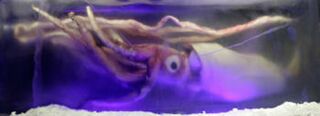
كل من الرخويات الأضخم والأكبر من جميع اللافقاريات (من حيث الكتلة) هي الحبار الأعظم. من المتوقع أن يكون الحبار الضخم (Mesonychoteuthis hamiltoni) أكبر اللافقاريات.[49] تضع التقديرات الحالية أقصى حجم لها عند 12 to 14 m (39 to 46 ft) بالطول و750 kg (1,650 lb)،[50] بناءً على تحليل عينات أصغر. في عام 2007، أعلنت السلطات النيوزيلندية اصطياد أكبر عينة من الحبار الضخم المعروفة. كان يُعتقد في البداية أنه 10 m (33 ft) و450 kg (990 lb). تم قياسه لاحقاً عند 4.2 m (14 ft) بالطول و495 kg (1,091 lb) في الوزن. كان الغطاء بطول 2.5 m (8.2 ft) بالطول عند القياس.[51][52]
كان يُعتقد سابقاً أن الحبار العملاق (Architeuthis dux) هو أكبر حبار، وعلى الرغم من أنه أقل كثافة وله غطاء أصغر من الحبار الضخم، إلا أنه قد يتجاوز الحبار الضخم في الطول الإجمالي بما في ذلك مخالب. إحدى عينات الحبار العملاقة التي جرفت الشاطئ عام 1878 في نيوفاوندلاند يقال إنها قيست 16.8 m (55 ft) في الطول الإجمالي (من طرف الغطاء حتى النهاية من المجسات الطويلة)، طول الرأس والجسم 6.1 m (20 ft)، 4.6 m (15 ft) في المحيط في أثخن جزء من الغطاء، ويزن حوالي 900 kg (2,000 lb). غالباً ما يُشار إلى هذه العينة على أنها أكبر اللافقاريات التي تم فحصها على الإطلاق.[28][53][54] ومع ذلك، لم توثق أي حيوانات القريبة من هذا الحجم علمياً، ووفقاً لخبراء الحبارات العملاقة ستيڤ أوشي، من المحتمل أن يتم تحقيق مثل هذه الأطوال عن طريق مد المجسّين بشكل كبير مثل العصبات المرنة.[55]
- حاملات الثلم\خنافس الورق (Aplacophora)
- أكبر الأنواع المعروفة من هذه الرخويات الشبيهة بالديدان والتي لا تحتوي على قشرة والتي تُمثل في جنس Epimenia، والذي يمكن أن يصل إلى 30 cm (12 in) بالطول. معظم حاملات الثلم أقل من 5 cm (2.0 in) بالطول.[56]
- عديدات الأصداف (Polyplacophora)
- أكبر الكيتونيات هي الكيتون الناري الغربي العملاق، Cryptochiton stelleri، والذي يمكن أن يصل طوله إلى 33 cm (13 in) ويزن أكثر من 2 kg (4.4 lb).[57]
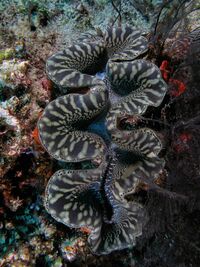
- ذوات الصدفتين (Bivalvia)
- أكبر من الرخويات ذوات الصدفتين هو البطلينوس العملاق\المحار الملزمي العملاق، Tridacna gigas. على الرغم من الإبلاغ عن أحجام أكبر لهذا الحيوان الخامل، إلا أن الحجم الأعلى الذي تم التحقق منه كان لعينة من الحاجز المرجاني العظيم. وزن هذا المخلوق 270 kg (600 lb)، وكان طوله المحوري 1.14 m (3.7 ft) وبعمق 0.75 m (2.5 ft).[28] أكبر ذوات الصدفتين على الإطلاق كان Platyceramus platinus، وهو عملاق من العصر طباشيري وصل إلى طول محوري يصل إلى 3 m.[58]
- بطنيات القدم (Gastropoda)
- يمكن تعريف "أكبر" فئة من الرخويات الأكثر تنوعاً من البزاق والحلزون بطرق مختلفة.
- أنواع بطنيات الأقدام الحية التي تحتوي على أكبر (أطول) قشرة هي البوق الأسترالي مع أقصى طول غلاف يبلغ 0.91 m (3.0 ft)، وزنها 18 kg (40 lb) وعرض 96 cm (38 in).[59][60] هناك نوع عملاق آخر هو Melo amphora، والذي في عينة من عام 1974 من غرب أستراليا، تم قياسها بطول 0.71 m (2.3 ft)، كان الحد الأقصى لمحيطها 0.97 m (3.2 ft) والوزن 16 kg (35 lb).[28]
- أكبر بطنيات الأقدام الخالية من الصدفة هي العملاق الأسود أرنب البحر الأسود (Aplysia vaccaria) في 0.99 m (3.2 ft) في الطول وتقريباً 14 kg (31 lb) بالوزن.
- أكبر الحلزونات اليابسة هو الحلزون الأفريقي العملاق (Achatina achatina) بمعدل يصل إلى 1 kg (2.2 lb) و35 cm (14 in) بالطول.
- رأسيات القدم (Cephalopoda)
- (انظر حجم رأسيات الأرجل.) بينما بشكل عام أصغر بكثير من الحبار العملاق وMesonychoteuthis، أكبر الأخطبوطات، أخطبوط المحيط الهادئ العملاق (Enteroctopus dofleini)، يمكن أن ينمو ليصبح كبيراً جداً. أكبر وزن مؤكد لأخطبوط عملاق هو 74 kg (163 lb)،[61] بامتداد ذراع 7 m (23 ft) (مع تمديد اللوامس بالكامل) وطول الرأس إلى طرف اللامسة 3.9 m (13 ft).[62] أُبلغ عن العينات حتى 125 kg (276 lb) ولكن لم يتم التحقق منها. الوزن من 10 إلى 50 كجم هو الحجم الأكثر شيوعاً.[28]
Velvet worms (Onychophora)
Solórzano's velvet worm (Peripatus solorzanoi) is the largest velvet worm known. An adult female was recorded to have a body length of 22 cm (approximately 8.7 in).[63]
Arthropods (Arthropoda)
The largest arthropod known to have existed is the eurypterid (sea scorpion) Jaekelopterus, reaching up to 2.5 m (8.2 ft) in body length, followed by the millipede relative Arthropleura at around 2.1 m (6.9 ft) in length.[64] Among living arthropods, the Japanese spider crab (Macrocheira kaempferi) is the largest in overall size, the record specimen, caught in 1921, had an extended arm span of 3.8 m (12 ft) and weighed about 19 kg (42 lb).[28] The heaviest is the American lobster (Homarus americanus), the largest verified specimen, caught in 1977 off of Nova Scotia weighed 20 kg (44 lb) and its body length was 1.1 m (3.6 ft).[28] The largest land arthropod and the largest land invertebrate is the coconut crab (Birgus latro), up to 40 cm (1.3 ft) long and weighing up to 4 kg (8.8 lb) on average. Its legs may span 1 m (3.3 ft).[28]
Arachnids (Arachnida)
Both spiders and scorpions include contenders for the largest arachnids.
- Spiders (Araneae)
- The largest species of arachnid by length is probably the giant huntsman spider (Heteropoda maxima) of Laos, which in 2008 replaced the Goliath birdeater (Theraphosa blondi) of northern South America as the largest known spider by leg-span.[65] However the most massive arachnids, of comparable dimensions and possibly even greater mass, are the Chaco golden knee (Grammostola pulchripes), and the Brazilian salmon pink (Lasiodora parahybana). The huntsman spider may span up to 29 cm (11 in) across the legs, while in the New World tarantulas like Theraphosa can range up to 26 cm (10 in).[28] In Grammostola, Theraphosa and Lasiodora, the weight is projected to be up to at least 150 g (5.3 oz) and body length is up to 10 cm (3.9 in).[66]
- Scorpions (Scorpiones)
- The largest of the scorpions is the species Heterometrus swammerdami of the Indian subcontinent, which have a maximum length of 29.2 cm (11.5 in) and weigh around 60 g (2.1 oz). Another extremely large scorpion is the African emperor scorpion (Pandinus imperator), which can weigh 57 g (2.0 oz) but is not known to exceed a length of 23 cm (9.1 in).[28] However, they were dwarfed by Pulmonoscorpius kirktonensis, a giant extinct species of scorpion from Scotland, at an estimated length of 0.7 m (2.3 ft) and weight of 15 kg (33 lb),[67] and the aquatic Brontoscorpio, at up to 1 m (3.3 ft) and a similar weight.[68][69]
- Pseudoscorpions (Pseudoscorpiones)
- The largest pseudoscorpion is Garypus titanius, from Ascension island, which can be 12 mm (0.47 in) long.[70]
Crustaceans (Crustacea)
The largest crustaceans are crab Tasmanian giant crab (''Pseudocarcinus gigas) 13 kilograms (29 lb) and a carapace width of up to 46 centimetres (18 in). It is the only species in the genus Pseudocarcinus.[71] Males reach more than twice the size of females.[72] It has a white shell with claws that are splashed in red. The females' shells change colour when they are producing eggs. At a length of up to 40 centimetres (16 in), Lysiosquillina maculata is the largest mantis shrimp in the world.[73] L. maculata may be distinguished from its congener L. sulcata by the greater number of teeth on the last segment of its raptorial claw, and by the colouration of the uropodal endopod, the distal half of which is dark in L. maculata but not in L. sulcata.[74] There is a small artisanal fishery for this species.[74] Tasmanian giant freshwater crayfish (Astacopsis gouldi) 5 kilograms (11 lb) in weight and over 80 centimetres (31 in) long have been known in the past, but now, even individuals over 2 kilograms (4.4 lb) are rare.[75] The species is only found in Tasmanian rivers flowing north into the Bass Strait below 400 metres (1,300 ft) above sea level, and is listed as an endangered species on the IUCN Red List.[76]
- Branchiopods (Branchiopoda)
- The largest of these primarily freshwater crustaceans is probably Branchinecta gigas, which can reach a length 10 cm (3.9 in).[77]
- Barnacles and allies (Maxillopoda)
- The largest species is Pennella balaenopterae, a copepod and ectoparasite specialising in parasitising marine mammals. The maximum size attained is 32 cm (about 13 in).[78] The largest of the barnacles is the giant acorn barnacle, Balanus nubilis, reaching 7 cm (2.8 in) in diameter and 12.7 cm (5.0 in) high.[79]
- Ostracods (Ostracoda)
- The largest living representative of these small and little-known but numerous crustaceans is the species Gigantocypris australis females of which reaching a maximum length of 3 cm (1.2 in).
- Amphipods, isopods, and allies (Peracarida)
- The largest species is the giant isopod (Bathynomus pergiganteus), which can reach a length of 45 cm (18 inches) and a weight of 1.7 kg (3.7 lb).[80]
- Remipedes (Remipedia)
- The largest of these cave-dwelling crustaceans is the species Godzillius robustus, at up to 4.5 cm (1.8 in).[81]
Horseshoe crabs (Xiphosura)
The four modern horseshoe crabs are of roughly the same sizes, with females measuring up to 60 cm (2.0 ft) in length and 5 kg (11 lb) in weight.[82]
Sea spiders (Pycnogonida)
The largest of the sea spiders is the deep-sea species Colossendeis colossea, attaining a leg span of nearly 60 cm (2.0 ft).[83]
Trilobites (Trilobita)
Some of these extinct marine arthropods exceeded 60 cm (24 in) in length. A nearly complete specimen of Isotelus rex from Manitoba attained a length over 70 cm (28 in), and an Ogyginus forteyi from Portugal was almost as long. Fragments of trilobites suggest even larger record sizes. An isolated pygidium of Hungioides bohemicus implies that the full animal was 90 cm (35 in) long.[84][85]
Myriapods (Myriapoda)
- Centipedes (Chilopoda)
- The biggest of the centipedes is Scolopendra gigantea of the neotropics, reaching a length of 33 cm (13 in).[86]
- Millipedes (Diplopoda)
- Two species of millipede both reach a very large size: Archispirostreptus gigas of East Africa and Scaphistostreptus seychellarum, endemic to the Seychelles islands. Both of these species can slightly exceed a length of 28 cm (11 in) and measure over 2 cm (0.79 in) in diameter.[28] The largest ever known was the Arthropleura, a gigantic prehistoric specimen that reached nearly 189 cm (74 in).
- Symphylans (Symphyla)
- The largest known symphylan is Hanseniella magna, originating in Tasmanian caves, which can reach lengths from 25 mm (0.98 in) up to 30 mm (1.2 in).[87]
Insects (Insecta)
Insects, a class of Arthropoda, are easily the most numerous class of organisms, with over one million identified species, and probably many undescribed species. The heaviest insect is almost certainly a species of beetle, which incidentally is the most species-rich order of organisms. Although heavyweight giant wetas (Deinacrida heteracantha) are known, the elephant beetles of Central and South America, (Megasoma elephas) and (M. actaeon), the Titan beetle (Titanus giganteus) of the neotropical rainforest or the Goliath beetles, (Goliathus goliatus) and (G. regius), of Africa's rainforest are thought to reach a higher weight.[88] The most frequently crowned are the Goliath beetles, the top known size of which is at least 100 g (3.5 oz) and 11.5 cm (4.5 in).[28] The elephant beetles and titan beetle can reach greater lengths than the Goliath, at up to 13.1 and 15.2 cm (5.2 and 6.0 in), respectively, but this is in part thanks to their rather large horns. The Goliath beetle's wingspan can range up to 25 cm (9.8 in).[28]
Some moths and butterflies have much larger areas than the heaviest beetles, but weigh a fraction as much.
The longest insects are the stick insects, see below.
Representatives of the extinct dragonfly-like order Protodonata such as the Carboniferous Meganeura monyi of what is now France and the Permian Meganeuropsis permiana of what is now North America are the largest insect species yet known to have existed. These creatures had a wingspan of some 75 cm (30 in) and a mass of over 1 pound (450 g), making them about the size of a crow.[28]
- Cockroaches and termites (Blattodea)
- The largest cockroach by body mass is the Australian giant burrowing cockroach (Macropanesthia rhinoceros), also known as the rhinoceros cockroach. This species can attain a length of 8.3 cm (3.3 in) and a weight of 36 g (1.3 oz). It does not have wings.[89] The Brazilian giant cockroach (Blaberus giganteus) of the neotropics reaches greater sizes of up to 10 cm in length and 15 cm in wingspan, although it is not as massive and heavy as the burrowing species. The termites, traditionally classified in their own order (Isoptera), have recently been re-considered to belong in Blattodea. The largest of the termites is the African species Macrotermes bellicosus. The queen of this species can attain a length of 14 cm (5.5 in) and breadth of 5.5 cm (2.2 in) across the abdomen; other adults, on the other hand, are about a third of the size.[28]
- Beetles (Coleoptera)
- The beetles are the largest order of organisms on earth, with about 400,000 species so far identified. The most massive species are the Goliathus, Megasoma and Titanus beetles already mentioned. Another fairly large species is the Hercules beetle (Dynastes hercules) of the neotropic rainforest with a maximum overall length of at least 19 cm (7.5 in) including the extremely long pronotal horn. The weight in this species does not exceed 16.5 g (0.58 oz).[28] The longest overall beetle is a species of longhorn beetle, Batocera wallacei, from New Guinea, which can attain a length of 26.6 cm (10.5 in), about 19 cm (7.5 in) of which is comprised by the long antennae.[28]
- Earwigs (Dermaptera)
- Since 1798, the largest of the earwigs has been the Saint Helena giant earwig (Labidura herculeana), endemic to the island of its name, measuring up to 8 cm (3.1 in) in length.[90] As of 2014, with the declaring of the organism extinct by the IUCN,[91] this may no longer be the case, although some believe a small number individuals are still extant.[92]
- True flies (Diptera)
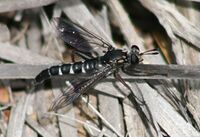
- The largest species of this order, which includes the common housefly, is the neotropical species Gauromydas heros, which can reach a length of 6 cm (2+3⁄8 in) and a wingspan of 10 cm (3.9 in).[28] Species of crane fly, the largest of which is Holorusia brobdignagius, can attain a length of 23 cm (9.1 in) but are extremely slender and much lighter in weight than Gauromydas.
- Mayflies (Ephemeroptera)
- The largest mayflies are members of the genus Proboscidoplocia from Madagascar. These insects can reach a length of 7 cm (2.8 in).[93]
- True bugs (Hemiptera)
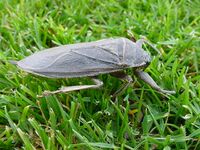
- The largest species of this diverse order is usually listed as the giant water bug in the genus Lethocerus, with L. maximus from the Neotropics being the absolutely largest.[94] They can surpass 12 cm (4.7 in) in length,[95] with some suggesting that the maximum size is 15 cm (5.9 in).[96] It is more slender and less heavy than most other insects of this size (principally the huge beetles). The largest cicada is Megapomponia imperatoria, which has a head-body length of about 7 cm (2.8 in) and a wingspan of 18–20 cm (7–8 in).[97][98] The cicadas of the genus Tacua can also grow to comparably large sizes. The largest type of aphid is the giant oak aphid (Stomaphis quercus), which can reach an overall length of 2 cm (0.79 in).[99] The biggest species of leafhopper is Ledromorpha planirostris, which can reach a length of 2.8 cm (1.1 in).[100]
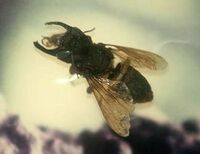 Megachile pluto, the largest bee.
Megachile pluto, the largest bee. - Ants and allies (Hymenoptera)
- The largest of the ants, and the heaviest species of the order, are the females of the African Dorylus helvolus, reaching a length of 5.1 cm (2.0 in) and a weight of 8.5 g (0.30 oz).[28] The ant that averages the largest for the mean size within the whole colony is a ponerine ant, Dinoponera gigantea, from South America, averaging up to 3.3 cm (1.3 in) from the mandibles to the end of abdomen.[28] Workers of the bulldog ant (Myrmecia brevinoda) of Australia are up to 3.7 cm (1.5 in) in total length, although much of this is from their extremely large mandibles.[28] The largest of the bee species, also in the order Hymenoptera, is Megachile pluto of Indonesia, the females of which can be 3.8 cm (1.5 in) long, with a 6.3 cm (2.5 in) wingspan. Nearly as large, the carpenter bees can range up to 2.53 cm (1.00 in).[28] The largest wasp is probably the so-called tarantula hawk species Pepsis pulszkyi of South America, at up to 6.8 cm (2.7 in) long and 11.6 cm (4.6 in) wingspan, although many other Pepsis approach a similar size. The giant scarab-hunting wasp Megascolia procer may rival the largest tarantula hawks in weight and wingspan, though its body is not as long.[28]
- Moths and allies (Lepidoptera)
- The Hercules moth (Coscinocera hercules), in the family Saturniidae, is endemic to New Guinea and northern Australia, and its wings have the largest documented surface area (300 square centimeters) of any living insect,[101][102] and a maximum wingspan which is confirmed to 28 cm (11 in) while unconfirmed specimens have spanned up to 35.5 cm (14.0 in). The largest species overall is often claimed to be either the Queen Alexandra's birdwing (Ornithoptera alexandrae), a butterfly from Papua New Guinea, or the Atlas moth (Attacus atlas), a moth from Southeast Asia. Both of these species can reach a length of 8 cm (3.1 in), a wingspan of 28 cm (11 in) and a weight of 12 g (0.42 oz). One Atlas moth allegedly had a wingspan of 30 cm (12 in) but this measurement was not verified.[28] The larvae in the previous species can weigh up to 58 and 54 g (2.0 and 1.9 oz), respectively. However, there are no reported measurements of surface area that would exceed the Hercules moth, and the white witch (Thysania agrippina) of Central and South America, has the largest recorded wingspan of the order, and indeed of any living insect, though the white witch is exceeded in surface area by the Hercules moth. The verified record-sized Thysania spanned 30.8 cm (12.1 in) across the wings, although specimens have been reported to 36 cm (14 in).[28] The heaviest mature moths have been cited in the giant carpenter moth (Xyleutes boisduvali) of Australia, which has weighed up to 20 g (0.71 oz) although the species does not surpass 25.5 cm (10.0 in) in wingspan.[28]
- Mantises (Mantodea)
- The largest species of this order is Toxodera denticulata from Java, which has been measured up to 20 cm (7.9 in) in overall length.[103] However, an undescribed species from the Cameroon jungle is allegedly much larger than any other mantis and may rival the larger stick insects for the longest living insect.[104] Among widespread mantis species, the largest is the Chinese mantis (Tenodera aridifolia). The females of this species can attain a length of up to 10.6 cm (4.2 in).
- Scorpionflies (Mecoptera)
- The largest scorpionfly, the common scorpionfly (Panorpa communis), can reach a body length of about 30 millimetres (1.2 in).[105] ;Alderflies and allies (Megaloptera)
- This relatively small insect order includes some rather large species, many of which are noticeable for their elongated, imposing mandibles. The dobsonflies reach the greatest sizes of the order and can range up to 12.5 cm (4.9 in) in length.[106]
- Net-winged insects (Neuroptera)
- These flying insects reach their largest size in Palparellus voeltzkowi, which can have a wingspan over 16 cm (6.3 in).[107] The largest lacewing is the "blue eyes lacewing" (Nymphes myrmeleonides) of Australia, which can measure up to 4 cm (1.6 in) in length and span 11 cm (4.3 in) across the wings.[108] Some forms of this ancient order could grow extremely large during the Jurassic Era and may have ranked among the largest insects ever.[109]
- Dragonflies (Odonata)
- The largest living species of dragonfly is Megaloprepus caerulatus of the neotropics, attaining a size of as much as 19 cm (7.5 in) across the wings and a body length of over 12 cm (4.7 in).[28] Spanning up to 17.6 cm (6.9 in) and measuring up to 11.8 cm (4.6 in) long, Tetracanthagyna plagiata of Southeast Asia is bulkier and heavier than Megaloprepus at up to 7 g (0.25 oz).[28] The largest species of dragonfly ever is the extinct aforementioned Meganeura, although it is not certain to be included in the modern dragonfly order.
- Grasshoppers and allies (Orthoptera)
- The largest of this widespread, varied complex of insects are the giant wetas of New Zealand, which is now split among 12 species. The largest of these is the Little Barrier Island giant weta (Deinacrida heteracantha), the largest specimen was weighed at 71.3 g (2.52 oz), one of the largest insects weights ever known. These heavyweight insects can be over 9 cm (3.5 in) long.[28] The largest grasshopper species is often considered to be the Australian giant grasshopper (Valanga irregularis), which ranges up to 9 cm (3.5 in) in length.[110] The American eastern lubber grasshopper (Romalea guttata) can allegedly range up to 10 cm (3.9 in) in length.[111] However, the greatest grasshopper sizes known, to 12 cm (4.7 in), have been cited in the South American giant grasshopper (Tropidacris violaceus). The longest members of this order (although much lighter than the giant wetas) is the katydid Macrolyristes corporalis of Southeast Asia which can range up to 21.5 cm (8.5 in) with its long legs extended and can have a wingspan of 20 cm (7.9 in).[112][113]
- Stick insects (Phasmatodea)
- The longest known stick insect, and indeed the longest insect ever known, is Phobaeticus chani of the Bornean rainforest, with one specimen held in the Natural History Museum in London measuring 56.7 cm (22.3 in) in total length.[114] This measurement is, however, with the front legs fully extended. The body alone still measures 35.7 cm (14.1 in).[115] The species with the second longest body is Phobaeticus kirbyi, also of Borneo, which measures up to 32.8 cm (12.9 in),[116] while the overall length (from the hind to the front legs) is up to 54.6 cm (21.5 in).[116] The second longest insect in terms of total length is Phobaeticus serratipes of Malaysia and Singapore, measuring up to 55.5 cm (21.9 in).[117] Another extremely long stick insect is Pharnacia maxima, which measured 51 cm (20 in) with its legs extended.[28] The spiny stick insect (Heteropteryx dilatata) of Malaysia does not reach the extreme lengths of its cousins, the body reaching up to 16 cm (6.3 in) long, but it is much bulkier. The largest Heteropteryx weighed about 65 g (2.3 oz) and was 3.5 cm (1.4 in) wide across the thickest part of the body.[28]
- Lice (Phthiraptera)
- These insects, which live parasitically on other animals, are as a rule quite small. The largest known species is the hog louse, Haematopinus suis, a sucking louse that lives on large livestock like pigs and cattle. It can range up to 6 mm (0.24 in) in length.[118]
- Stoneflies (Plecoptera)
- The largest species of stonefly is Pteronarcys californica of western North America, a species favored by fishermen as lures. This species can attain a length of 5 cm (2.0 in) and a wingspan of over 9.5 cm (3.7 in).[119]
- Booklice (Psocoptera)
- The largest of this order of very small insects are the barklice of the genus Psocus, the top size of which is about 1 cm.[120]
- Fleas (Siphonaptera)
- The largest species of flea is Hystrichopsylla schefferi. This parasite is known exclusively from the fur of the mountain beaver (Aplodontia rufa) and can reach a length of 1.2 cm (0.47 in).[28]
- Silverfishes and allies (Thysanura)
- These strange-looking insects, known to feed on human household objects, can range up to 4.3 cm (1.7 in) in length. A 350 million year old form was known to grow quite large, at up to 6 cm (2.4 in).[121]
- Thrips (Thysanoptera)
- Members of the genus Phasmothrips are the largest kinds of thrips. The maximum size these species attain is approximately 1.3 cm (0.51 in) in length.[122]
- Caddisflies (Trichoptera)
- The largest of the small, moth-like caddisflies is Eubasilissa maclachlani. This species can range up to 7 cm (2.8 in) across the wings.[123]
- Angel insects (Zoraptera)
- The largest angel insect species, Hubbard's angel insect (Zorotypus hubbardi), grows up to 3 mm (0.12 in) in length.[124][125]
النباتات
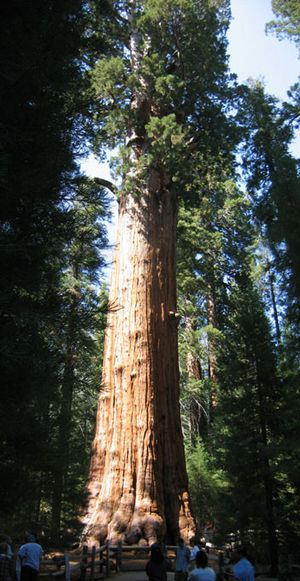
The largest single-stem tree by wood volume and mass is the giant sequoia (Sequoiadendron giganteum), native to Sierra Nevada and California; it typically grows to a height of 70–85 m (230–280 ft) and 5–7 m (16–23 ft) in diameter.
The largest organism in the world, according to mass, is the aspen tree whose colonies of clones can grow up to 8 kilometres (5 mi) long. The largest such colony is Pando, in the Fishlake National Forest in Utah.
Another form of flowering plant that rivals Pando as the largest organism on earth in breadth, if not mass, is the giant marine plant, Posidonia oceanica, discovered in the Mediterranean near the Balearic Islands, Spain. Its length is about 8 km (5 mi). It may also be the oldest living organism in the world, with an estimated age of 100,000 years.[6]
The largest individual flower in the world is Rafflesia arnoldii, while the flowering plant with the largest unbranched inflorescence in the world is Amorphophallus titanum, both are native to Sumatra island of indonesia.
الطحالب الخضراء
Green algae are photosynthetic unicellular and multicellular protists that are related to land plants. The thallus of the unicellular mermaid's wineglass, Acetabularia, can grow to several inches (perhaps 0.1 to 0.2 m) in length. The fronds of the similarly unicellular, and invasive Caulerpa taxifolia can grow up to a foot (0.3 m) long.[بحاجة لمصدر]
الفطريات
أكبر فطر حي قد يكون فطر العسل[126] of the species Armillaria ostoyae.[127] A mushroom of this type in the Malheur National Forest in the Blue Mountains of eastern Oregon, U.S. was found to be the largest fungal colony in the world, spanning 8.9 km2 (2,200 acres) of area.[4][5] This organism is estimated to be 2,400 years old. The fungus was written about in the April 2003 issue of the Canadian Journal of Forest Research. While an accurate estimate has not been made, the total weight of the colony may be as much as 605 tons[vague]. If this colony is considered a single organism, then it is the largest known organism in the world by area, and rivals the aspen grove "Pando" as the known organism with the highest living biomass. It is not known, however, whether it is a single organism with all parts of the mycelium connected.[5]
A spatial genetic analysis estimated that a specimen of Armillaria ostoyae growing over 91 acres (37 ha) in northern Michigan, United States weighs 440 tons (4 x 105 kg).[128][129] Approximations of the land area of the Oregon "humongous fungus" are 3.5 square miles (9.1 km2) (2,240 acres (910 ha), possibly weighing as much as 7,500 tons as the world's most massive living organism.[130]
In Armillaria ostoyae, each individual mushroom (the fruiting body, similar to a flower on a plant) has only a 5 cm (2.0 in) stipe, and a pileus up to 12.5 cm (4.9 in) across. There are many other fungi which produce a larger individual size mushroom. The largest known fruiting body of a fungus is a specimen of Phellinus ellipsoideus (formerly Fomitiporia ellipsoidea) found on Hainan Island.[131] The fruiting body masses up to 500 kg (1,100 lb).[132][133]
Until P. ellipsoideus replaced it, the largest individual fruit body came from Rigidoporus ulmarius. R. ulmarius can grow up to 284 kg (626 lb), 1.66 m (5.4 ft) tall, 1.46 m (4.8 ft) across, and has a circumference of up to 4.9 m (16 ft).
الطفيليات
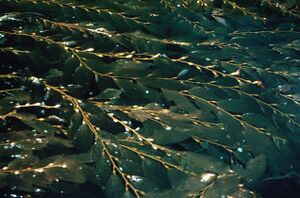
(Note: the group Protista is not used in current taxonomy.)
Amoebozoans (Amoebozoa)
- Among the organisms that are not multicellular, the largest are the slime molds, such as Physarum polycephalum, some of which can reach a diameter over 30 cm (12 in).[134] These organisms are unicellular, but they are multinucleate.
Euglenozoans (Euglenozoa)
- Some euglenophytes, such as certain species of Euglena, reach lengths of 400 μm.[135]
Rhizarians (Rhizaria)
- The largest species traditionally considered protozoa are giant amoeboids like foraminiferans. One such species, the xenophyophore Syringammina fragilissima, can attain a size of 20 cm (7.9 in).[136]
Alveolates (Alveolata)
- The largest ciliates, such as Spirostomum, can attain a length over 4 mm (0.16 in).[137]
Stramenopiles (Stramenopila)
- The largest stramenopiles are giant kelp from the northwestern Pacific. The floating stem of Macrocystis pyrifera can grow to a height of over 45 m (148 ft).[138][139]
- Macrocystis also qualifies as the largest brown alga, the largest chromist, and the largest protist generally.
البكتريا
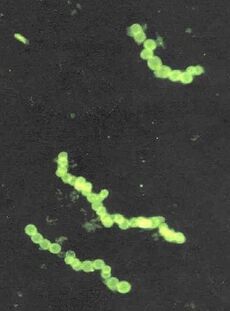
The largest known species of bacterium is Thiomargarita namibiensis, which grows to 0.75 mm (0.030 in) in diameter, making it visible to the naked eye and a thousand times the size of more typical bacteria.
- Cyanobacteria
- One of the largest "blue green algae" is Lyngbya, whose filamentous cells can be 50 μm wide.[140]
الڤيروسات
The largest virus on record is the Pithovirus sibericum with the length of 1.5 micrometres, comparable to the typical size of a bacterium and large enough to be seen in light microscopes. It was discovered in March 2014 in an ice core sample collected from a permafrost in Siberia. Prior to this discovery, the largest virus was the peculiar virus genus Pandoravirus, which have a size of approximately 1 micrometer and whose genome contains 1,900,000 to 2,500,000 base pairs of DNA.[141]
Both these viruses infect amoebas specifically.
انظر أيضاً
- أصغر الكائنات الحية
- عمالقة البحار العميقة
- حيوان عملاق
- أكبر عضو في الجسم
- Charismatic megafauna
- أكبر عضيات قبل التاريخ
الهامش
- ^ Consensus Document on the Biology of Populus، منظمة التعاون الاقتصادي والتنمية (.doc file)
- ^ Quaking Aspen by the Bryce Canyon خدمة المتنزهات الوطنية
- ^ largest living thing
- ^ أ ب The Humongous Fungus--Ten Years Later at the University of Wisconsin, Department of Botany. Accessed 20 August 2005. خطأ استشهاد: وسم
<ref>غير صالح؛ الاسم "UW" معرف أكثر من مرة بمحتويات مختلفة. - ^ أ ب ت Beale, Bob. 10 April 2003. Humungous fungus: world's largest organism? at Environment & Nature News, ABC Online. Accessed 20 August 2005. خطأ استشهاد: وسم
<ref>غير صالح؛ الاسم "ABCfungus" معرف أكثر من مرة بمحتويات مختلفة. - ^ أ ب Ibiza's Monster Marine Plant. Ibiza Spotlight, 28 May 2006. خطأ استشهاد: وسم
<ref>غير صالح؛ الاسم "seagrass" معرف أكثر من مرة بمحتويات مختلفة. - ^ The General Sherman Tree, Sequoia National Park at the National Park Service. Accessed 20 August 2005.
- ^ superlative trees
- ^ Hokkanen, J.E.I. (21 February 1986). "The size of the largest land animal". Journal of Theoretical Biology. Elsevier Ltd. Volume 118, Issue 4: 491–499. doi:10.1016/S0022-5193(86)80167-9.
{{cite journal}}:|volume=has extra text (help) Department of Theoretical Physics, University of Helsinki. - ^ <http://rarestzoo.blogspot.com/2006/07/long-beaked-echidna.html>
- ^ <http://www.helium.com/items/891104-kangaroo-largest-species-kangaroos>
- ^ ADW: Orycteropus afer: Information
- ^ ADW: Hippopotamus amphibius: Information
- ^ African giraffes endangered | Environment | Reuters
- ^ [1] BBC Wildfacts
- ^ "African Rhinoceros". Safari Now. Retrieved 2008-03-19.
- ^ Rinderknecht, Andrés (2008-01-15). "The largest fossil rodent" (pdf). Proceedings of the Royal Society B Biological Sciences. 275: 923. doi:10.1098/rspb.2007.1645. Retrieved 2008-01-16.
{{cite journal}}: Check date values in:|date=(help); Unknown parameter|coauthors=ignored (|author=suggested) (help); Unknown parameter|laysummary=ignored (help) - ^ Crocodylus porosus (Schneider, 1801), by Adam Britton from the Crocodilian Species List.
- ^ http://news.boloji.com/200701/00800.htm
- ^ birding.com records
- ^ فيل الأحراش الأفريقي
- ^ الفيل الآسيوي
- ^ Biggest, Smallest, Fastest, Deepest: Marine Animal Records – Marine Biology: Life in the Ocean. Care2.com (2009-03-04)
- ^ Xestospongia muta. Encyclopedia of Life
- ^ Yahel, G.; Eerkes-Medrano, D. I.; Leys, S. P. (2006). "Size independent selective filtration of ultraplankton by hexactinellid glass sponges". Aquatic Microbial Ecology. 45: 181–194. doi:10.3354/ame045181.
- ^ Rare sighting of a lion’s mane jellyfish in Tramore Bay. waterford-today.ie
- ^ "Lion's Mane Jellyfish". jellyfishfacts.net. Retrieved 14 June 2017.
- ^ أ ب ت ث ج ح خ د ذ ر ز س ش ص ض ط ظ ع غ ف ق ك ل م ن هـ و ي أأ أب أت أث أج أح أخ أد أذ أر أز أس خطأ استشهاد: وسم
<ref>غير صحيح؛ لا نص تم توفيره للمراجع المسماةWood - ^ Sea Anemones, Sea Anemone Pictures. Northrup.org
- ^ Tube Anemones – Ceriantharia. Seawater.no
- ^ Praya picture. Lifesci.ucsb.edu
- ^ Portuguese Man-of-Wars, Portuguese Man-of-War Pictures, Portuguese Man-of-War Facts. Animals.nationalgeographic.com
- ^ "Longest Giant Stringy Sea Creature Ever Recorded Looks like It Belongs in Outer Space". interestingengineering.com (in الإنجليزية الأمريكية). 2020-04-09. Retrieved 2020-04-10.
- ^ Schmidt Ocean Institute (9 April 2020). "New species discovered during exploration of abyssal deep sea canyons off Ningaloo". EurekAlert!. Retrieved 12 April 2020.
- ^ "Neoentobdella gen. nov for species of Entobdella Blainville in Lamarck, 1818 (Monogenea, Capsalidae, Entobdellinae) from stingray hosts, with descriptions of two new species" (PDF). Acta Parasitologica. 50 (1): 32–48. 2005.
- ^ DPDx – Fasciolopsiasis. Dpd.cdc.gov Archived سبتمبر 27, 2011 at the Wayback Machine
- ^ The Persistent Parasites. Time Magazine (1957-04-08)
- ^ Hargis, William J. Parasitology and pathology of marine organisms of the world ocean Archived 2011-10-15 at the Wayback Machine. National Oceanic and Atmospheric Administration (1985)
- ^ Gubanov, NM (21 April 1951). "Гигантская нематода из плаценты китообразных Placentonema gigantissima nov. gen., nov. sp" [Giant nematoda from the placenta of Cetacea; Placentonema gigantissima nov. gen., nov. sp] (PDF). Doklady Akademii Nauk SSSR (in الروسية). 77 (6): 1123–1125. PMID 14822893. Archived from the original (PDF) on 15 December 2013.
- ^ Natural History Collections: Nematoda. Nhc.ed.ac.uk
- ^ The Mighty Worm. Worm Digest (2005-10-02) Archived فبراير 19, 2009 at the Wayback Machine
- ^ أ ب Mah, Christopher (2008-07-27). "What Are the World's LARGEST Starfish?". The Echinoblog.
- ^ Ponsonby, David and Dussart, George The Anatomy of the Sea, Raincoast Books (2005) ISBN 0-8118-4633-4 p. 129
- ^ أ ب ت ث Gilpin, D. (2006). Echinoderms - Starfish, Urchins, and Other Echinoderms. p. 41. ISBN 978-0-7565-1611-6.
- ^ "Strongylocentrotus franciscanus". Animal Diversity Web. Retrieved 2 December 2016.
- ^ "Long-spined black sea urchin". Wild Singapore. Retrieved 2 December 2016.
- ^ Mah, Christopher (2009-04-27). "The World's BIGGEST Brittle Stars!". The Echinoblog.
- ^ Carwardine, M. 1995. The Guinness Book of Animal Records. Guinness Publishing. p. 232.
- ^ Photo in the News: Colossal Squid Caught off Antarctica. News.nationalgeographic.com (2010-10-28)
- ^ "The UnMuseum - The Colossal Squid". www.unmuseum.org. Retrieved 14 June 2017.
- ^ Kathy Marks. NZ's colossal squid to be microwaved. The New Zealand Herald (2007-03-23)
- ^ "How big is the colossal squid?". Te papa. Archived from the original on 2008-12-17.
- ^ Giant Squids, Architeuthis dux. Marinebio.org
- ^ Giant Squid, Giant Squid Pictures, Giant Squid Facts. Animals.nationalgeographic.com (2006-12-04)
- ^ O'Shea, S. 2003. "Giant Squid and Colossal Squid Fact Sheet". The Octopus News Magazine Online.
- ^ Salvini-Plawen, L. V. (1997). "Systematic Revision of the Epimeniidae (Mollusca: Solenogastres)". Journal of Molluscan Studies. 63 (2): 131–155. doi:10.1093/mollus/63.2.131.
- ^ Gumboot Chiton. alaska.gov
- ^ Kauffman, E. G.; Harries, P. J.; Meyer, C.; Villamil, T.; Arango, C.; Jaecks, G. (2007). "Paleoecology of Giant Inoceramidae (Platyceramus) on a Santonian (Cretaceous) Seafloor in Colorado". Journal of Paleontology. 81: 64–81. doi:10.1666/0022-3360(2007)81[64:POGIPO]2.0.CO;2.
- ^ John D. Taylor and Emily A. Glover. Food of giants – field observations on the diet of Syrinx aruanus (Linnaeus, 1758) (Turbinellidae) the largest living gastropod, in F. E. Wells, D. I. Walker and D. S. Jones (eds.) 2003. The Marine Flora and Fauna of Dampier, Western Australia. Western Australian Museum, Perth.
- ^ Largest snails in the world – Giant African snail. largestfastestsmartest.co.uk
- ^ Cosgrove, James Albert (1987). Aspects of the natural history of Octopus dofleini, the giant Pacific octopus (Thesis). hdl:1828/12155.
- ^ [Octopus – Species].[استشهاد ناقص]
- ^ Morera-Brenes, B.; Monge-Nájera, J. (2010). "A new giant species of placented worm and the mechanism by which onychophorans weave their nets (Onychophora: Peripatidae)". Revista de Biología Tropical. 58 (4): 1127–1142. arXiv:1511.00983. doi:10.15517/rbt.v58i4.5398. PMID 21246983. S2CID 6456946.
- ^ Tetlie, O. E.; Poschmann, M.; Braddy, S. J. (2008). "Giant claw reveals the largest ever arthropod". Biology Letters. 4 (1): 106–109. doi:10.1098/rsbl.2007.0491. PMC 2412931. PMID 18029297.
- ^ "First Contact". panda.org. Archived from the original on 2017-02-24. Retrieved 14 June 2017.
- ^ Poisonous Animals: Tarantula (Grammostola, Phrixothrichus). Library.thinkquest.org
- ^ Animales prehistóricos: Pulmonoscorpius. Animalesprehistoricos.com (August 2009)
- ^ Fossil Insects and Crustaceans. SDNHM Archived فبراير 3, 2012 at the Wayback Machine
- ^ Erik N. Kjellesvig-Waering (1972). "Brontoscorpio anglicus: A Gigantic Lower Paleozoic Scorpion from Central England". Journal of Paleontology. 46 (1): 39–42. JSTOR 1302906.
- ^ Jan Beccaloni (2009). "Pseudoscorpiones". Arachnids. Natural History Museum. p. 271. ISBN 978-0-520-26140-2.
- ^ P. K. L. Ng; D. Guinot; P. J. F. Davie (2008). "Systema Brachyurorum: Part I. An annotated checklist of extant Brachyuran crabs of the world" (PDF). Raffles Bulletin of Zoology. 17: 1–286. Archived from the original (PDF) on 2011-06-06.
- ^ D. R. Currie; T. M. Ward (2009). South Australian Giant Crab (Pseudocarcinus gigas) Fishery (PDF). South Australian Research and Development Institute. Fishery Assessment Report for PIRSA. Retrieved 9 December 2013.
- ^ Roy Caldwell. "Species: Lysiosquillina maculata". Roy's List of Stomatopods for the Aquarium. University of California Museum of Paleontology. Retrieved February 14, 2009.
- ^ أ ب "Lysiosquillidae" (PDF). The Living Marine Resources of the Western Central Pacific. pp. 835–837.[dead link]
- ^ "Tasmanian Giant Freshwater Lobster (Astacopsis gouldi)". Department of the Environment, Water, Heritage and the Arts. February 9, 2007. Retrieved March 16, 2010.
- ^ T. Walsh & N. Doran (2010). "Astacopsis gouldi". IUCN Red List of Threatened Species. 2010: e.T2190A9337732. doi:10.2305/IUCN.UK.2010-3.RLTS.T2190A9337732.en.
- ^ Branchinecta gigas (crustacean). Britannica Online Encyclopaedia
- ^ Pennella balaenopterae. Animaldiversity.ummz.umich.edu
- ^ Giant Acorn Barnacle. Oregon Coast Aquarium Archived أكتوبر 9, 2011 at the Wayback Machine
- ^ Knight, J.D. Giant Isopod – Deep Sea Creatures on Sea and Sky. Seasky.org
- ^ Remipedia: Species – robustus, Godzillius. Crustacea.net (2002-10-02)
- ^ Horseshoe Crabs, Limulus polyphemus at. Marinebio.org
- ^ Sea spiders Facts, information, pictures. work=Encyclopedia.com (2004-10-22)
- ^ Gutierrez-Marco, J. C.; Sa, A. A.; Garcia-Bellido, D. C.; Rabano, I.; Valerio, M. (2009). "Giant trilobites and trilobite clusters from the Ordovician of Portugal". Geology. 37 (5): 443–446. Bibcode:2009Geo....37..443G. doi:10.1130/G25513A.1.
- ^ Giant Trilobites in Portugal Could Be Biggest Portugal – Discovery News. Dsc.discovery.com (2009-05-07). Archived مايو 10, 2009 at the Wayback Machine
- ^ Scolopendra gigantea. Arachnoboards.com (2003-08-13)
- ^ Minelli, Alessandro; Sergei I. Golovatch (2001). "Myriapods" (PDF). In Simon A. Levin (ed.). Encyclopedia of Biodiversity. pp. 291–303. ISBN 978-0122268656. Archived from the original (PDF) on 2014-02-21.
- ^ "Largest". Archived from the original on يوليو 18, 2011. Retrieved يونيو 10, 2009.
{{cite web}}: CS1 maint: bot: original URL status unknown (link)(2011). source: The University of Florida Book of Insect Records "Largest". Archived from the original on August 20, 2014. Retrieved 2009-06-10. - ^ Creature Features – Giant Burrowing Cockroach Archived 2014-02-18 at the Wayback Machine. Abc.net.au
- ^ The Giant Earwig of St. Helena Labidura herculeana. Earwig Research Centre. Earwigs-online.de
- ^ Trust), David Pryce (St Helena National; Liza White (Environment and Natural Resources Directorate, St Helena Government) (2014-08-22). "IUCN Red List of Threatened Species: Labidura herculeana". IUCN Red List of Threatened Species.
- ^ "Gone for good: world's largest earwig declared extinct". Mongabay Environmental News (in الإنجليزية الأمريكية). 2014-11-19. Retrieved 2021-10-12.
- ^ Madagascan mayfly hyper-diversity. The BioFresh blog (2011-05-24)
- ^ P. J. Perez-Goodwyn (2006). Taxonomic revision of the subfamily Lethocerinae Lauck & Menke (Heteroptera: Belostomatidae)". Stuttgarter Beiträge zur Naturkunde. A (Biologie) 695: 1–71.
- ^ Haddad Jr; Schwartz; Schwartz; and Carvalho (2010). Bites Caused by Giant Water Bugs Belonging to Belostomatidae Family (Hemiptera, Heteroptera) in Humans: A Report of Seven Cases. Wilderness & Environmental Medicine 21: 130–133.
- ^ BBC News (26 May 2011). Giant water bug photographed devouring baby turtle. Retrieved 27 August 2014.
- ^ Burton, Maurice; Burton, Robert (2002). International Wildlife Encyclopedia. 4, Chickaree - crabs (3rd ed.). Tarrytown, NY: Marshall Cavendish Corporation. p. 455. ISBN 0-7614-7270-3
- ^ Flindt, R. (2006). Amazing Numbers in Biology, p. 10. ISBN 978-3540301462
- ^ Giant Oak Aphid hunt is on. The Telegraph (2007-08-08)
- ^ Ledromorpha planirostris. Bugs.bio.usyd.edu.au
- ^ Robert G. Foottit & Peter H. Adler. 2009. Insect Biodiversity: Science and Society. Blackwell Publishing Ltd. ISBN 978-1-405-15142-9
- ^ Rainier Flindt. 2006. Amazing Numbers in Biology. Springer-Verlag, Berlin. ISBN 3-540-30146-1
- ^ Live Pet Mantis Hobby. Bugsincyberspace.com
- ^ Craig Glenday (2009). Guinness World Records 2009. Random House Digital, Inc. p. 53. ISBN 978-0-553-59256-6.
- ^ UK Safari
- ^ Dobsonfly. Real Monstrosities (2011-01-26)
- ^ Palparellus voeltzkowi (Kolbe, 1906). Researcharchive.calacademy.org
- ^ Bio-Ditrl, Department of Biological Sciences, University of Alberta Archived يوليو 6, 2011 at the Wayback Machine
- ^ Michael S. Engel (2005). "A remarkable kalligrammatid lacewing from the Upper Jurassic of Kazakhstan (Neuroptera: Kalligrammatidae)". Transactions of the Kansas Academy of Science. 108 (1): 59–62. doi:10.1660/0022-8443(2005)108[0059:arklft]2.0.co;2. JSTOR 3628206.
- ^ Giant Grasshoppers – The largest grasshopper – Valanga irregularis. Brisbaneinsects.com
- ^ Eastern Lubber Grasshopper – Florida eco travel guide. Wildflorida.com
- ^ Crickets Grasshoppers and Katydids: Orthoptera – Physical Characteristics – Wings, Legs, Forewings, and Species. Animals.jrank.org
- ^ Giant Long-Legged Katydid Archived 2016-03-07 at the Wayback Machine. Hmns.org
- ^ World's longest insect revealed. Natural History Museum (2008-10-16) Archived أكتوبر 19, 2008 at the Wayback Machine
- ^ Hennemann, F. H. & Conle, O. V. (2008). "Revision of Oriental Phasmatodea: The tribe Pharnaciini Günther, 1953, including the description of the world's longest insect, and a survey of the family Phasmatidae Gray, 1835 with keys to the subfamilies and tribes (Phasmatodea: "Anareolatae": Phasmatidae)" (PDF). Zootaxa. Auckland, New Zealand. 1906: 1–316. doi:10.11646/zootaxa.1906.1.1.
- ^ أ ب Brock, P.D. 1999. The amazing world of stick and leaf-insects. Cravitz Printing Co., Essex, England.
- ^ Seow-Choen, F. (1995). "The longest insect in the world". Malayan Nat. 48: 12.
- ^ ADW: Haematopinus suis: Information. Animaldiversity.ummz.umich.edu
- ^ Pteronarcys californica – aka Giant Stonefly or Giant Salmonfly. Riverwood Blog – Fly Fishing Gear & Guided Fishing Trips in Oregon (2009-04-20) Archived أبريل 2, 2012 at the Wayback Machine
- ^ National Barkfly (Outdoor Psocoptera) Recording Scheme. Brc.ac.uk
- ^ Silverfish and Fire Brats: Thysanura – Physical Characteristics – Head, Thysanuran, Inches, and Millimeters. Animals.jrank.org
- ^ List of largest insects. Paulsquiz.com Archived يوليو 14, 2015 at the Wayback Machine
- ^ Diptera.info – Discussion Forum: The LARGEST caddisfly of the world.
- ^ Foottit, Robert G.; Adler, Peter H. (2018). Insect Biodiversity: Science and Society. Wiley. pp. 199–207. ISBN 978-1-118-94560-5.
- ^ Engel, Michael S. (2005). "Zoraptera". Tree of Life Web Project. Retrieved 9 March 2019.
- ^ Mycologist's site about giant Armillaria in Michigan's Upper Peninsula. Botit.botany.wisc.edu.
- ^ report about the largest Armillaria in the world. BBC News (2000-08-07).
- ^ Anderson, A.; Sand, C.; Petchey, F.; Worthy, T. H. (2010). "Faunal extinction and human habitation in New Caledonia: Initial results and implications of new research at the Pindai Caves". Journal of Pacific Archaeology. 1 (1): 89–109. hdl:10289/5404.
- ^ Jason Daley (15 October 2018). "This humongous fungus is as massive as three blue whales: A new estimate suggests this mushroom is 2,500 years old and weighs 440 tons". Smithsonian.com. Retrieved 23 September 2019.
- ^ Vince Patton (12 February 2015). "Oregon Humongous Fungus Sets Record As Largest Single Living Organism On Earth (7 minute documentary video)". Oregon Field Guide. Retrieved 23 September 2019.
- ^ Walker, Matt. (2011-08-01) Giant fungus discovered in China. Bbc.co.uk
- ^ Dai, Y. C.; Cui, B. K. (2011). "Fomitiporia ellipsoidea has the largest fruiting body among the fungi". Fungal Biology. 115 (9): 813–814. doi:10.1016/j.funbio.2011.06.008. PMID 21872178.
- ^ Cui, Bao-Kai; Decock, Cony (2013). "Phellinus castanopsidis sp. nov (Hymenochaetaceae) from southern China, with preliminary phylogeny based on rDNA sequences". Mycological Progress. 12 (2): 341–351. doi:10.1007/s11557-012-0839-5. S2CID 17570036.
- ^ Slime Mold Photos. Waynesword.palomar.edu
- ^ "Protist Images: Euglena gigas". Protist Information Server. 2004.
- ^ The 27 Best Deep-Sea Species: #22 Xenophyophores. Deep Sea News (2008-10-10).
- ^ Wim van Egmond. Spirostomum. Microscopy-uk.org.uk.
- ^ Macrocystis pyrifera (giant kelp) | Natural History Museum. Nhm.ac.uk. Archived نوفمبر 2, 2011 at the Wayback Machine
- ^ Giant kelp, Kelp Forest, Plants & Algae, Macrocystis pyrifera. Montereybayaquarium.org
- ^ Stal, Lucas J. (2007). "Diversity and Versatility, Clues to Life in Extreme Environments". In Seckbach, J. (ed.). Algae and Cyanobacteria in Extreme Environments. Cellular Origin, Life in Extreme Habitats and Astrobiology. Vol. Volume 11, Part 7. Dordrecht, The Netherlands: Springer. pp. 659–680 (666). doi:10.1007/978-1-4020-6112-7_36. ISBN 978-1-4020-6111-0.
{{cite book}}:|volume=has extra text (help) - ^ Brumfiel, Geoff (18 July 2013). "World's Biggest Virus May Have Ancient Roots". National Public Radio. Retrieved 18 July 2013.
المصادر
- Wood, The Guinness Book of Animal Facts and Feats. Sterling Pub Co Inc (1983), ISBN 978-0851122359
- [3]
- IUCN African Elephant Specialist Group (AfESG): Statement on the Taxonomy of extant Loxodonta (February, 2006).
- CS1 errors: extra text: volume
- CS1 errors: unsupported parameter
- CS1 الإنجليزية الأمريكية-language sources (en-us)
- CS1 الروسية-language sources (ru)
- Articles with incomplete citations from November 2021
- All articles with incomplete citations
- Articles with dead external links from December 2017
- CS1 maint: bot: original URL status unknown
- مقالات ذات عبارات بحاجة لمصادر
- Articles with unsourced statements from January 2021
- Articles with unsourced statements from December 2016
- مقالات ينقصها مصادر موثوقة
- مقالات ينقصها مصادر موثوقة from January 2016
- All Wikipedia articles needing clarification
- Wikipedia articles needing clarification from January 2010
- علم الحيوان
- عضيات
- أرقام قياسية عالمية
- صيغ تفضيل
- Size



